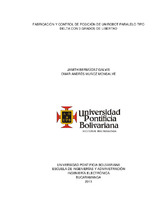| dc.contributor.advisor | Silva, Luis Ángel | |
| dc.contributor.author | Bermúdez Galvis, Jamith | |
| dc.contributor.author | Muñoz Monsalve, Omar Andrés | |
| dc.coverage.spatial | Seccional Bucaramanga. Universidad Pontificia Bolivariana. Escuela de Ingenierías. Facultad de Ingeniería Electrónica | spa |
| dc.coverage.temporal | 2011 | |
| dc.date.accessioned | 2014-09-09T20:07:04Z | |
| dc.date.available | 2014-09-09T20:07:04Z | |
| dc.date.created | 2011-09-08 | |
| dc.date.issued | 2014-09-09 | |
| dc.identifier.uri | http://hdl.handle.net/20.500.11912/1661 | |
| dc.description | 131p.: (pdf); il; gráficas; tablas; anexos | spa |
| dc.description.abstract | En este proyecto se presenta la fabricación de un prototipo de robot paralelo tipo delta con 3 grados de libertad y la implementación del control digital de posición de lazo cerrado implementando un PI. Inicialmente se desarrolló un modelo de simulación en ADAMS partiendo de unas dimensiones establecidas y unos pesos máximos. Se realizó un análisis de trayectorias que permitió encontrar las trayectorias críticas donde los pares son máximos y se eligieron motores comerciales capaces de desarrollar ese par. Después de la compra de los motores se diseñaron las piezas mecánicas en el software de diseño SolidWorks, y se procedió a su fabricación, seguidamente se implementó el control digital en microcontroladores dsPIC de Microchip en una configuración Maestro-Esclavo empleando comunicación serial. Para la visualización de las variables controladas, se diseñó una interfaz gráfica en LabVIEW. El prototipo busca motivar el desarrollo tecnológico de la región y la construcción de máquinas para automatizar procesos industriales a un costo inferior al del mercado, proporcionando a los empresarios métodos para mejorar sus líneas de producción. | spa |
| dc.description.abstract | This project presents the fabrication of a prototype parallel robot type delta with 3 degrees of freedom and the implementation of a digital position control by implementing a closed loop PI. Initially it was developed a simulation model in ADAMS based on set dimensions and maximum weights. It performed a trajectory analysis that allowed find critical paths where the torques are maximum and it chose commercial motors that they can develop this torque. After the purchase of motors, mechanical parts were designed in the design software SolidWorks, and it was proceeded to manufacture, then it implemented the digital control in dsPIC microcontrollers from Microchip in a Master-Slave configuration using serial communication. For the visualization of the controlled variables, it was designed a graphical interface in LabVIEW. The prototype seeks encourage the technological development in the region and the construction of machines to automate industrial processes at a cost below the market, providing business methods to improve their production lines. | |
| dc.language.iso | es | |
| dc.publisher | Universidad Pontificia Bolivariana | spa |
| dc.rights | Attribution-NonCommercial-NoDerivatives 4.0 International | * |
| dc.rights.uri | http://creativecommons.org/licenses/by-nc-nd/4.0/ * | * |
| dc.subject | Ingeniería electrónica | spa |
| dc.subject | Robots | spa |
| dc.subject | Robótica | spa |
| dc.subject | Motores | spa |
| dc.subject | Software | spa |
| dc.subject | Controladores de dispositivos (Programas para computador) | spa |
| dc.subject | Desarrollo científico y tecnológico | spa |
| dc.title | Fabricación y control de posición de un robot paralelo tipo Deltacon3 grados de libertad | spa |
| dc.type | bacherlorThesis | spa |
| dc.rights.accessRights | openAccess | spa |
| dc.type.hasVersion | publishedVersion | spa |
| dc.identifier.instname | instname:Universidad Pontificia Bolivariana | spa |
| dc.identifier.reponame | reponame:Repositorio Institucional de la Universidad Pontificia Bolivariana | spa |
| dc.identifier.repourl | repourl:https://repository.unab.edu.co/ | |


